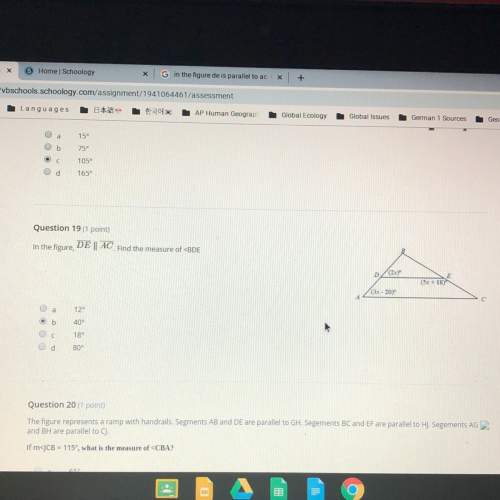
Mathematics, 04.12.2019 06:31 JJ143899
Let r+ denote the set of positive real numbers. let f : r × r+ → r be given by f(x, y) = x/y. (a) is f an injective function? prove your answer. (b) is f a surjective function? again, prove your answer. (c) is f a bijection? prove your answer.

Answers: 1


Another question on Mathematics

Mathematics, 21.06.2019 14:50
Which equations represents circles that have a diameter of 12 units and a center that lies on the y-axis? check all that apply
Answers: 1

Mathematics, 21.06.2019 19:00
Simplify. −4x^2 (5x^4−3x^2+x−2) −20x^6−12x^4+8x^3−8x^2 −20x^6+12x^4−4x^3+8x^2 −20x^8+12x^4−4x^2+8x −20x^6+12x^4+4x^3−8x^2
Answers: 1

Mathematics, 21.06.2019 19:40
Aretha wanted to gather data about the cost of local bowling leagues in her area. she plotted the data and determined that the average bowling league costs consist of a one-time registration fee and a monthly fee modeled by the equation y = 15x + 20. identify and interpret the y-intercept in this model. the y-intercept is 20. this is the cost per month. the y-intercept is 20. this is the cost of registration. the y-intercept is 15. this is the cost of registration. the y-intercept is 15. this is the cost per month.
Answers: 1

Mathematics, 22.06.2019 00:30
Which number can each term of the equation be multiplied by to eliminate the decimals before solving? 5.6j- 0.12=4+1.1j
Answers: 3
You know the right answer?
Let r+ denote the set of positive real numbers. let f : r × r+ → r be given by f(x, y) = x/y. (a) i...
Questions


Biology, 27.06.2019 10:30

Mathematics, 27.06.2019 10:30



Mathematics, 27.06.2019 10:30






Mathematics, 27.06.2019 10:30






Mathematics, 27.06.2019 10:30


 .
. is injective if
is injective if  for any two points
for any two points  and
and  , then the two points must be identical with
, then the two points must be identical with  and
and  .
.

 for which every point in the codomain
for which every point in the codomain  is obtained by
is obtained by  .
. and can take on any negative real number for any choice of
and can take on any negative real number for any choice of 
 if and only if
if and only if 
 for any choice of
for any choice of 



